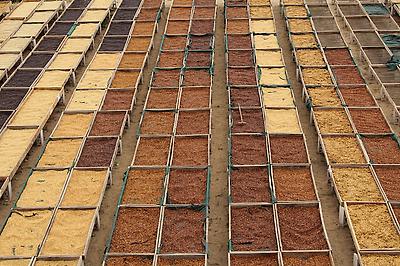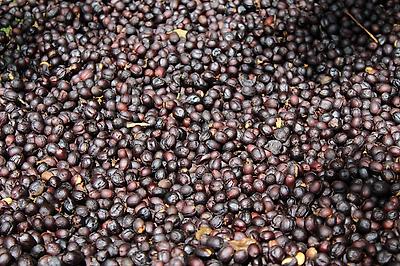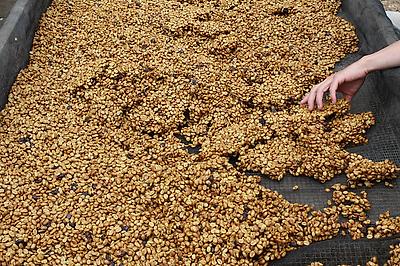Honey Processing - An Introduction

General Processing Techniques
There are a number of standard processing techniques for coffee that you may be aware of. The two main ones are washed coffee and natural coffees. For washed coffees the skin and fruit (mucilage) of the coffee cherry is removed and the coffee cherry is washed down to it's parchment and it is then dried. For natural processing, the coffee is laid out to dry without removing any of the coffee fruit and when it has dried out completely it is then dry milled to remove the dried fruit.
Washed coffee generally gives a sweeter and cleaner cup, it's the processing method that people in the US are most familiar with. However it does take a lot of water to process and sometimes in a competitive market the coffees aren't as standout as they might be by another processing method. Natural coffees on the other hand can have much more funky interesting flavors depending on the fermentation that happens in the coffee cherry while it dries. This can save on water but the fermentation process can be unpredictable and very hard to control for the farmer.

Ok, so thats the intro to coffee processing, where does Honey processed coffee come in? Sure, honey processing is a kind of a halfway point between these two techniques. The skin and some of the mucilage (the fruit of the coffee cherry) is removed mechanically when the cherry is picked. The cherry is then dried with the mucilage in tact and when it is sufficiently dried it is dry milled to remove the dried mucilage.
Sounds simple right? Not really. You've probably heard all about different color cherries from white, through yellow to red and black. What are all of these colors about, what do they represent? The simple and most straightforward answer is "it depends". There is no standard terminology or methodology for creating honeys. Nearly every farmer you speak to has a different process and technique. So, to give a little insight I'm going to describe some things I gleaned from a recent trip to El Salvador and Costa Rica.

Colored Honeys
The central principle in creating honeys is controlling the fermenting process of the mucilage on the coffee bean. The mucilage is high in sugar and so will ferment when exposed to the air and the heat. Increased heat will dry out the bean fast and stop the fermentation. On the other end of the scale, a long drawn out drying process at the ambient temperatures will prolong the fermentation process. There were two main techniques used to control the fermentation we came across in Costa Rica and El Salvador.
Degree of Mucilage Removal
The first technique was calibrating the demucilager to remove a certain portion of the mucilage and then drying as normal on the patio or raised bed until the bean was at the appropriate moisture content. So, leaving most of the mucilage on the cherry would result in more of a fermentation and taking the majority of the mucilage off the cherry would result in less fermentation. The spectrum usually goes from less fermentation to more fermentation, White honey, yellow honey, red honey, black honey. White is the least amount of fermentation with black being the most fermentation. So a white honey might leave 25% of the mucilage on while a black might leave all the mucilage but remove the skin. The other honeys are in between. Of course there is no standard between processors this is just a general rule of thumb and different producers have different names for the degree of fermentation.
Time left before first turning
This technique is based around the amount and frequency of the turning of the coffee as it is drying. The processor removes a set proportion of the mucilage and then creates the different honeys by turning the coffee on different schedules. The process is straightforward. By exposing the drying beans to air and sun the bean will dry and the fermentation process will stop. On the other hand, by allowing the drying bean to sit without being disturbed the fermentation process will continue.
For lighter honeys (e.g. white honeys), the beans might sit for a day before their first turning and be turned regularly after that. For darker honeys (e.g. yellow and red), they can sit two, three or more days before they get turned for the first time. For black honeys, they can sit under shade to extend the fermentation process even more.
Get in my mug
When processing honeys there are lots of different ways to achieve similar goals. Hopefully we've shed some light on the different terms people use and the methods used to achieve the final product. There is no hard and fast terminology or methodology perhaps in the future people will settle on a standard technique - but I doubt it. Either way good producers will keep doing whats best for their coffee and we stand to benefit with tastier and tastier coffee in our mugs.
